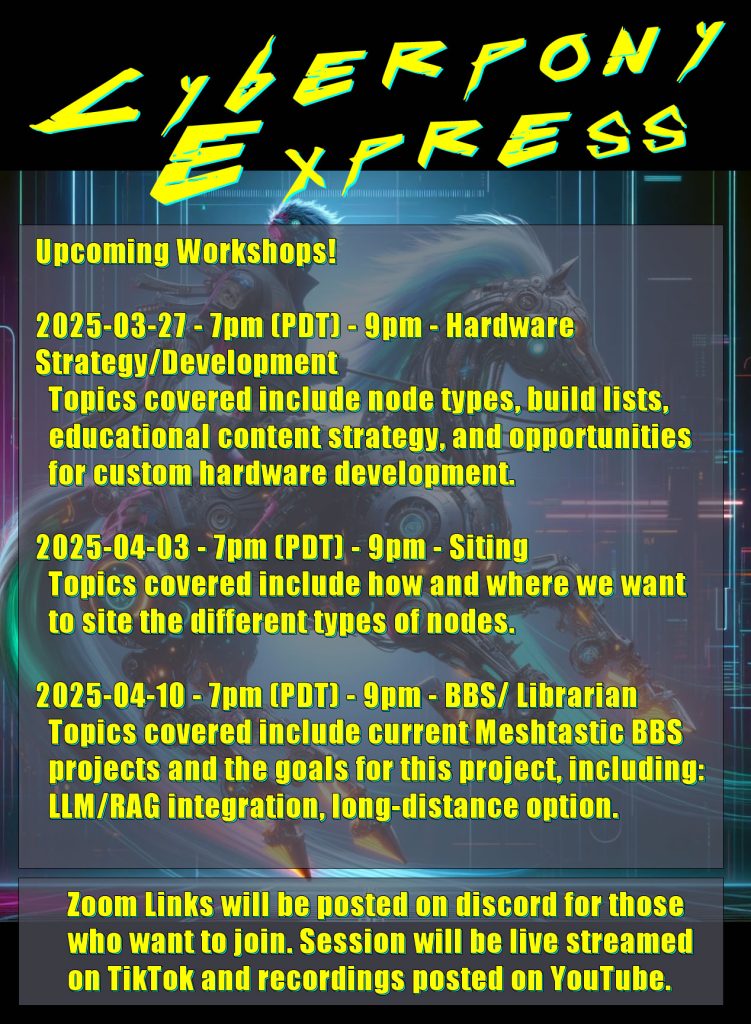The High Desert Institute partnered with Burning Man, Burners Without Borders, and The Multiverse School to throw an initial workshop at Burning Man Global Headquarters on March 13th at 7pm. This covered the plans, the technology, and the partnerships we’ve been working on developing so far.
We had close to a hundred in-person attendees, and hundreds more online. The reaction and enthusiasm is more than we dreamed of! Topics for follow-up meetings include:
- Hardware Strategy/ Development: We are putting together a team to work on developing our hardware strategy to minimize cost of installation and maintenance as well as how we will talk about the different roles the hardware can fill.
- Clients: A lora device you take with you and use on a regular basis.
- Routers: Stationary nodes which are permanently located and feature large antennas and sturdy enclosures as well as being located on rooftops and wherever appropriate for maximum coverage.
- We also discussed including weather sensors and telemetry related to public health such as air quality and geiger counters.
- Resource Hubs: Nodes being placed at community gardens and other community locations should also include additional resource distribution hardware:
- Internet in a box: These simple devices contain a complete offline copy of free, open-source, web-based software including Wikipedia, Appropredia, open-source mapping software, etc. All of this is accessible via wifi, and community members are free to set up wifi boosters and repeaters or use the Cyberpony BBS to chat with LLMs that can answer questions based on the contents of the library.
- The Cyberpony BBS: The bulletin-board service allows users to leave messages for others, as well as send long-distance messages to distant parts of the world, across gaps in the network. It also allows users to chat with LLMs hosted on-device about the contents of the local resource library, including answering complex questions based on retrieval-augmented-generation within the local, offline digital library.
- We also discussed creating a less complex system combining concepts from IIAB and BBS based on a simple ESP32 + 2TB SD Card to provide these services directly from all the router nodes. For example, many current lora nodes like the LillyGo-T3S3 already have the option to serve files from an integrated sd card reader which could host terabytes of content locally at very little cost.
- Client Education: We need follow-up workshops and content focused on helping community members get their clients set up and able to communicate on the network.
- Citing: We need to have meetings about about how and where to place the routers, and find people who want to do that work.
- We also need to put together a pipeline to identify and reach out to community gardens willing to host routers and resource hubs.
- We are in touch with local amateur radio clubs which seem excited to host routers at their various hilltop repeater sites.
What’s Next
✨Expect smoother streaming and recording from our upcoming remote-only sessions ✨ 😂
Zoom Links will be posted on discord for those who want to join. Session will be live streamed on TikTok and recordings posted on YouTube.
- 2025-03-27 – 7pm (PDT) – 9pm – Hardware Strategy/Development
- Topics covered include node types, build lists, educational content strategy, and opportunities for custom hardware development.
- 2025-04-03 – 7pm (PDT) – 9pm – Siting
- Topics covered include how and where we want to site the different types of nodes
- 2025-04-10 – 7pm (PDT) – 9pm – BBS/ Librarian
- Topics covered include current Meshtastic BBS projects and the goals for this project, including: LLM/RAG integration, long-distance option.
Flyer for sharing:
